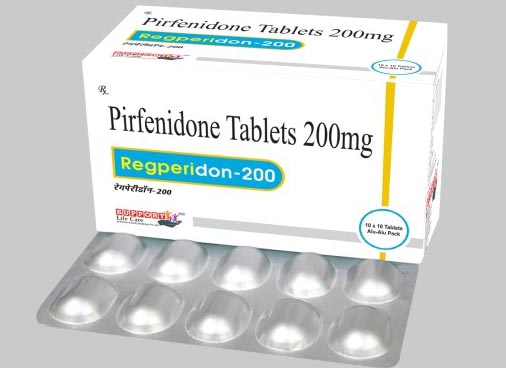Nikhil Prasad Fact checked by:Thailand Medical News Team Aug 07, 2024 8 months, 1 week, 4 days, 2 hours, 19 minutes ago
Med News: Fibrotic interstitial lung diseases (FILDs) represent a group of conditions characterized by scarring of the lung tissue, leading to serious breathing difficulties and decreased quality of life. These diseases encompass a wide range of conditions, including idiopathic pulmonary fibrosis (IPF), connective tissue disease-associated interstitial lung disease (CTD-ILD), and lung diseases caused by environmental and occupational exposures. This
Med News report covers a study reviews by researchers from Yanbian University-China, Ruibo International Business School-China, Renmin University of China and the Chinese Academy of Medical Sciences and Peking Union Medical College-China on the potential of pirfenidone, a drug known for its antifibrotic and anti-inflammatory properties, to treat these conditions. The findings are significant, especially for those seeking alternatives to existing therapies.
 Pirfenidone brings hope for fibrotic interstitial lung diseases
Pirfenidone: A Breakthrough Drug
Pirfenidone brings hope for fibrotic interstitial lung diseases
Pirfenidone: A Breakthrough Drug
Pirfenidone has been a game-changer in the treatment of idiopathic pulmonary fibrosis (IPF), a severe form of FILD. With over a decade of clinical use, pirfenidone has proven effective in slowing disease progression and improving patients' quality of life. The drug works by reducing inflammation and preventing further scarring of lung tissues. Its approval marked the first significant advancement in the treatment of IPF, providing hope to many patients who previously had limited options.
Expanding Use Beyond IPF
Recent research has explored pirfenidone's potential in treating other types of FILDs. These studies are critical as they offer hope for patients suffering from various forms of lung fibrosis.
Occupational and Environmental Lung Diseases
One area of interest is the use of pirfenidone for lung diseases caused by environmental and occupational exposures. For instance, fibrotic hypersensitivity pneumonitis (FHP), often resulting from exposure to organic dust, saw positive outcomes with pirfenidone treatment. Patients in clinical trials showed significant improvements in lung function and quality of life. The drug was well-tolerated, with manageable side effects. Moreover, silicosis, an occupational disease caused by inhaling silica particles, has also been investigated. Animal studies have shown that pirfenidone can reduce lung inflammation and fibrosis in silicosis, suggesting potential benefits for human patients.
Connective Tissue Disease-Associated ILD (CTD-ILD)
CTD-ILD is another condition where pirfenidone has shown promise. This disease is linked to autoimmune disorders like rheumatoid arthritis and systemic sclerosis. These conditions cause chronic inflammation that can lead to lung fibrosis. In clinical trials, patients with CTD-ILD treated with pirfenidone experienced slower lung function decline and better disease management. The drug's anti-inflammatory properties help reduce the progression of fibrosis, offering a new avenue for treatment. Specifically, in rheumat
oid arthritis-associated ILD, pirfenidone has been shown to slow the decline in lung function significantly, providing much-needed relief to patients.
Post-COVID-19 Pulmonary Fibrosis
One of the most exciting areas of research involves post-COVID-19 pulmonary fibrosis. The COVID-19 pandemic has left many patients with lingering lung damage, resembling pulmonary fibrosis. This condition arises when the body's response to severe COVID-19 infection leads to excessive scarring in the lungs. Early studies suggest that pirfenidone could help these patients by reducing inflammation and preventing further scarring. This potential was highlighted in trials where patients treated with pirfenidone showed less severe lung damage and better recovery outcomes. The drug's ability to modulate key signaling pathways involved in fibrosis, such as TGF-β1, makes it a promising candidate for treating post-COVID-19 lung complications.
Real-World Evidence and Ongoing Research
Real-world data from various countries have supported the findings of clinical trials, showing that pirfenidone is effective and safe for long-term use. For example, studies from Taiwan and the USA have demonstrated that patients on pirfenidone experience improved lung function and reduced disease progression. However, more extensive studies are necessary to fully understand its benefits across different FILD subtypes.
In occupational and environmental lung diseases, the RELIEF trial provided encouraging results, particularly for patients with chronic hypersensitivity pneumonitis. The trial demonstrated that pirfenidone could slow disease progression and improve patient outcomes, supporting its use in this challenging condition.
For CTD-ILD, trials like TRAIL1 have highlighted pirfenidone's ability to manage rheumatoid arthritis-associated ILD effectively. The LOTUSS study further confirmed its safety and potential benefits for systemic sclerosis-associated ILD, marking significant steps forward in the treatment of these complex diseases.
In post-COVID-19 pulmonary fibrosis, preliminary studies have shown that pirfenidone can reduce the severity of lung damage and improve patient recovery. However, more research is needed to confirm these findings and establish optimal treatment protocols.
Addressing Side Effects
While pirfenidone is generally well-tolerated, some patients may experience side effects such as gastrointestinal discomfort and skin reactions. Most side effects are mild to moderate and can be managed with dose adjustments. Studies have shown that reducing the dose can help maintain efficacy while minimizing adverse effects. For instance, a study in Korea demonstrated that lowering the daily dose of pirfenidone from 1,800 mg to 1,200 mg significantly delayed the decline in lung function, suggesting that dose adjustments can enhance patient compliance and treatment outcomes.
Conclusion
The potential of pirfenidone in the treatment of various fibrotic interstitial lung diseases is high, offering hope to many patients. While more research is needed to fully understand its benefits across different FILD subtypes, current evidence suggests that pirfenidone is a safe and effective option. The consistency in its safety profile across various studies further supports its use beyond IPF.
Overall, pirfenidone represents a promising therapeutic option for patients with FILDs, potentially improving their quality of life and disease outcomes. The ongoing research and clinical trials will continue to shed light on its efficacy and safety, paving the way for broader applications in lung fibrosis treatment.
The study findings were published in the peer-reviewed journal: Frontiers in Medicine.
https://www.frontiersin.org/journals/medicine/articles/10.3389/fmed.2024.1411279/full
For the latest on Fibrosis, keep on logging to Thailand
Med News.
Read Also:
https://www.thailandmedical.news/news/individuals-who-had-covid-19-without-pneumonia-at-higher-risk-for-pulmonary-fibrosis-than-those-with-pneumonia
https://www.thailandmedical.news/news/the-uniqueness-of-post-covid-lung-fibrosis-the-increased-expression-of-atp12a-protein
